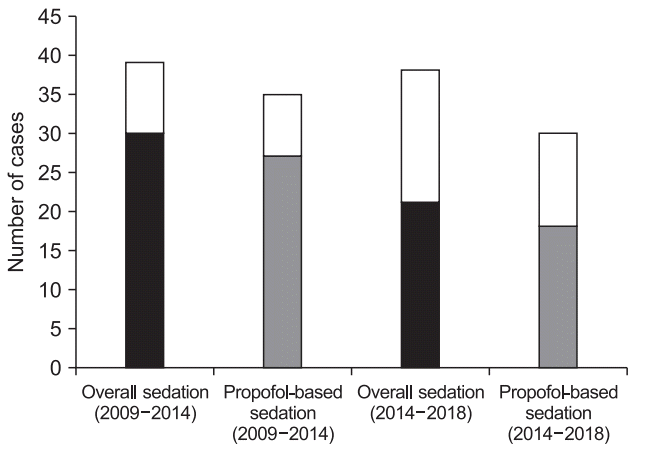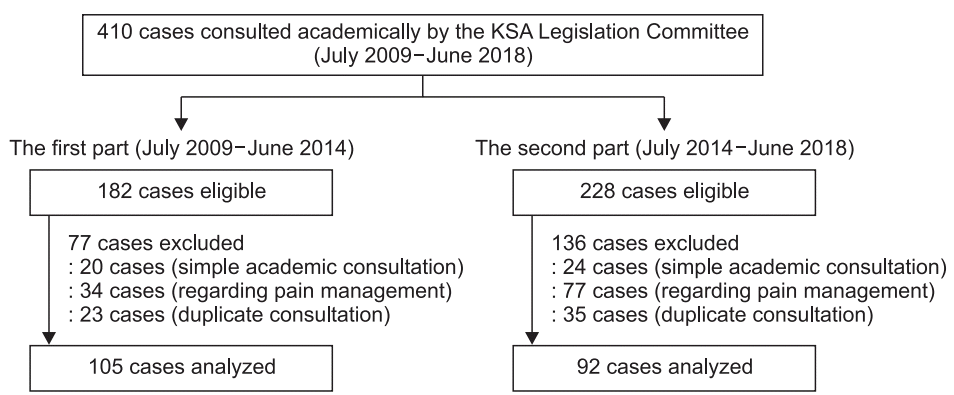Abstract
Background
Methods
Results
Conclusions
Notes
Author contributions
Ji Won Choi (Formal analysis; Methodology; Validation; Visualization)
Duk Kyung Kim (Conceptualization; Formal analysis; Writing – original draft)
Choon Kyu Cho (Validation; Writing – review & editing)
Soo Jung Park (Formal analysis; Methodology)
Yong Hun Son (Formal analysis; Methodology)
References
Fig. 2.

Table 1.
| 2009-2014(n=105) | 2014-2018(n =92) | P value | |
|---|---|---|---|
| Age (yr) | 43.0 (26.5-55.5) | 50.5 (33.3-63.5) | 0.006* |
| Gender (F/M) | 53/52 | 57/35 | 0.140 |
| ASA physical status (I/II/III or VI) | 63/32/10 | 53/31/8 | 0.885 |
| Hospital type (local clinic/local hospital/general or academic hospital) | 46/32/27 | 45/28/19 | 0.665 |
| Type of procedure (diagnostic/cosmetic/therapeutic) | 11/27/67 | 7/27/58 | 0.711 |
| Clinical specialty (OS/PS/GS/IM/OB&GY/others) | 24/18/18/10/9/26 | 36/20/7/12/5/12 | 0.023* |
| Type of anesthesia (GA/sedation/SP/ED/PNB/LA) | 50/39/7/4/2/3 | 26/38/12/9/5/2 | 0.036* |
| Timing of adverse events (induction/maintenance/recovery/at ward/discharge) | 23/34/19/25/4 | 8/47/21/13/3 | 0.014* |
| Complications† (temporary/permanent [minor]/permanent [major]/death) | 3/4/16/82 | 12/10/20/50 | 0.002* |
| Appropriateness of anesthetic care‡ (avoidable/possibly avoidable /probably unavoidable) | 45/31/29 | 31/30/31 | 0.404 |
Values are expressed as numbers of cases or medians (interquartile range). ASA: American Society of Anesthesiologists, OS: orthopedic surgery, PS: plastic surgery, GS: general surgery, IM: internal medicine, OB&GY: obstetrics and gynecology, GA: general anesthesia, SP: spinal anesthesia, ED: epidural anesthesia, PNB: peripheral nerve block, LA: local anesthesia.
* Statistically significant at P < 0.05. Categorical variables: Pearson’s χ2-test with a continuity correction or Fisher’s exact test, continuous variables: unpaired t-test or Mann–Whitney U test.
† Complications were classified into 4 categories: temporary, permanent/minor, permanent/major, and death. ‘Permanent/major’ injuries included severe brain damage, quadriplegia, and paraplegia requiring lifelong care or having a fatal prognosis; other permanent injuries were considered to be ‘permanent/minor’.
‡ Appropriateness of anesthesia care was graded on a 1–9 point scale (1 = completely avoidable injury, 9 = completely unavoidable injury, if an appropriate standard of care had been used). Then, they were classified into a 3-category preventability scale (1–3, avoidable; 4–6, possibly avoidable; 7–9, probably unavoidable).
Table 2.
|
GA (n = 76) |
Sedation (n = 77) |
|||
|---|---|---|---|---|
| 2009–2014 | 2014–2018 | 2009–2014 | 2014–2018 | |
| Timing of adverse events (induction/maintenance/after procedures) | 13-7-30 | 3-5-18 | 6-21-12 | 1/31/6 |
| Pre-anesthetic test (absent/present) | 1/49 | 0/26 | 32/7 | 27/11 |
| Pre-anesthetic evaluation record (absent/present) | 23/27 | 16/10 | 36/3 | 35/3 |
| Anesthesia record (absent/present) | 0/50 | 0/26 | 35/4 | 29/9 |
| Grade of intraoperative monitoring* (grade I/II/III/IV) | 0/0/25/25 | 0/1/15/10 | 6/21/11/1 | 7/22/9/0 |
| Supplemental oxygen (no/yes) | 0/50 | 0/26 | 24/15 | 30/8 |
| Anesthesia or sedation provider (nurse/anesthesiologist/other doctors) | 1/49/0 | 1/25/0 | 0/3/36 | 0/2/36 |
| Permanent (minor/major)/death | 1-7-42 | 3-7-16 | 0/6/30 | 3-11-21 |
| Appropriateness of anesthesia care† (avoidable/possibly avoidable/probably unavoidable) | 13/19/18 | 3-7-16 | 27-7-5 | 21/15/2 |
* Intraoperative monitoring: grade I, no monitoring; grade II, pulse oximetry only; grade III, grade II plus non-invasive blood pressure measurement and/or electrocardiography; grade IV, grade III plus capnography.
† Appropriateness of anesthetic care was graded on a 1–9 point scale (1 = completely avoidable injury, 9 = completely unavoidable injury, if an appropriate standard of care had been used). Then, they were classified into a 3-category preventability scale (1–3, avoidable; 4–6, possibly avoidable; 7–9, probably unavoidable).




 PDF
PDF Citation
Citation Print
Print




 XML Download
XML Download